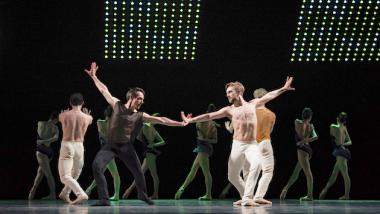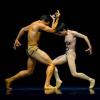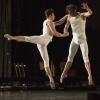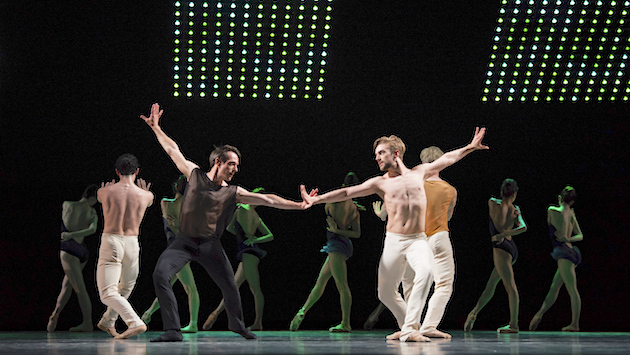
There was a pleasing sense of hoopla at the War Memorial Opera House last weekend as the San Francisco Ballet’s long-awaited Unbound festival of new works arrived, bounding and flying, slipping and sliding, swirling and leaping, mostly to the San Francisco Ballet Orchestra, under the artistic direction of Martin West.
The six premieres in two shows were labeled, logically enough, programs A and B. The big kickoff, Program A Friday night, featured three marquee choreographers: Alonzo King (The Collective Agreement), Christopher Wheeldon (Bound To), and Justin Peck (Hurry Up, We’re Dreaming); on B’s docket, Saturday night, were works by Myles Thatcher (Otherness), Cathy Marston (Snowblind), and David Dawson (Anima Animus).
When the entire four-program run consists of 12 new works by choreographers invited by Artistic Director Helgi Tomasson to create ballets for his company, the unspoken and generally unrealistic expectation is that all the work will be terrific. That can have a strange effect. When the excitement of Unbound subsides, will the enthusiasm for the new ballets simmer down too?
When it’s over, Tomasson is expected to choose four or five new ballets to fill in the blanks deliberately left open in the company’s 2018-19 season. Show biz loves contests — the Oscars, the Grammys, the Tonys, American Idol, So You Think You Can Dance, and on and on. So ... Which ballets will Tomasson choose? And we’re off.
Alonzo King, whose beautiful company, LINES Ballet, has been based in San Francisco since 1982, has never made a ballet for SFB, although he’s choreographed for Ailey, Bejart, Frankfurt, Hubbard Street, the Joffrey, and many other troupes. The Collective Agreement, for a cast of 20, seems, collectively, devoid of agreement. With its ballerinas on pointe, as LINES dancers often are, it’s full of interesting moves, including boldly beautiful, deep arabesques for the women in tights and soaring jetés for the bare-chested men in white trousers, but they don’t cohere. King seems to be picking up ideas, trying them, and discarding them in favor of new ones.
The upshot is indescribable — a strangely tranquil chaos, maybe. The costumes reflect that discursive quality as well. The dancers, led by principals Sofiane Sylve and Tiit Helimets, Jahna Frantzikonis and Joseph Warton, are in practice wear, but other women, strangely, appear in costume designer Robert Rosenwasser’s short, spangled, navy tutus with feathered hips, like aspiring peacocks, with suggestions of Swan Lake-ish movement, arms fluttering.
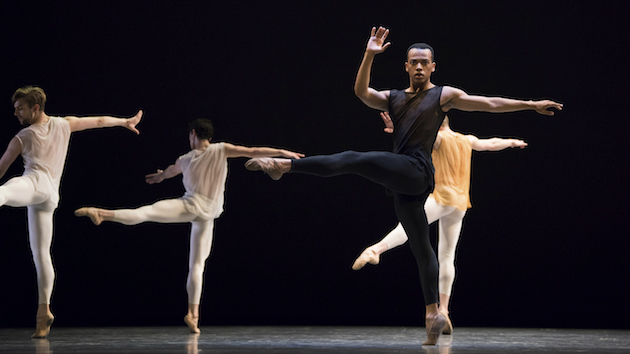
The men’s clothes are unremarkable until corps member Solomon Golding appears in a knee-length pleated skirt. He looks a little like a lost church lady. Later on, he’s in pants. Everyone’s on the same stage (there’s no other choice), so perhaps that is the collective and coexistent agreement. The music, an original score by jazz pianist Jason Moran, includes occasional cracks of a whip that seem to engender no reaction among the company. However, the sheer energy of King’s choreography, with its myriad balances, its multiplicity of ports de bras, its vivacious leaps and attentive partnering, held the eye while the brain thrashed around looking for ... what? Anyway, as if by collective agreement, King and company brought the house down.
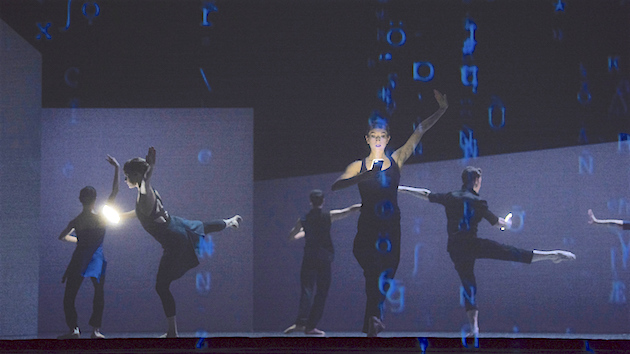
Thematically, Christopher Wheeldon’s Bound To was the King ballet’s polar opposite; that is, it had a theme, interludes with their own names, and at its end, a message, in Times New Roman on an electronic screen (designed by James F. Ingalls, who lit the entire program). It was quite simply that electronic gadgets are destroying our human connection to each other.
But Wheeldon is blessed with great choreographic ability, a facility for propulsive movement, style, insight, and wit, and the strong message was lightly, even delightfully delivered.
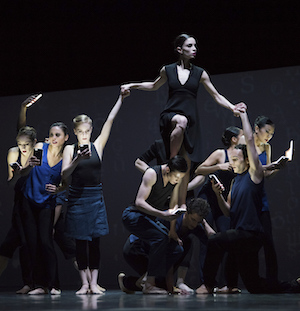
The lights went up on dancers transfixed by their cell phones; in fact, the phones were part of the lighting. Wheeldon kept the women off pointe to emphasize their human qualities, as did the conversational quality of composer Keaton Henson’s music, strong on strings.
But oh, the abnormal normalcy of telephonic possession. We laugh as Dores André tries in vain to divert Benjamin Freemantle’s attention from his phone. It’s called “Open Your Eyes.” Later, four women (Sasha De Sola, André, Isabella DeVivo, and Jennifer Stahl) forsake their phones to spend time enjoying each other’s company, sitting around with plenty of affectionate touching. The section’s titled “Remember When We Used to Talk.”
Correspondingly, four men (Jaime Garcia Castilla, Freemantle, Angelo Greco, and Lonnie Weeks) let go in space-gobbling leaps for “Remember When We Used to Play.” “Take a Deep Breath” ensues after Yuan Yuan Tan has her phone jerked out of her hand, leading to a tender pas de deux with Carlo Di Lanno. In between these dances and others are superb ensemble romps — like the ones Wheeldon, the New York City Ballet’s resident choreographer, did for Broadway’s An American in Paris — unencumbered by handheld devices. As the piece ends, there’s a quote from a study finding that teen suicides have risen with the increased use of social media and handheld devices, a chilly finale for a warmly human creation.
Justin Peck, too, has handled Broadway assignments in his brief yet stellar choreographic career (he’s also a New York City Ballet soloist), most recently the new Broadway revival of Carousel. Peck, 30, whose In the Countenance of Kings, is a notable addition to the SFB repertory, is still finding his way. A reviewer recently commented that his work still hasn’t revealed much of who he is. He seems to be many entities and perhaps hasn’t quite figured out how to keep them sorted. For Unbound, he’s created Hurry Up, We’re Dreaming, which lacks not for movement, but has no center.
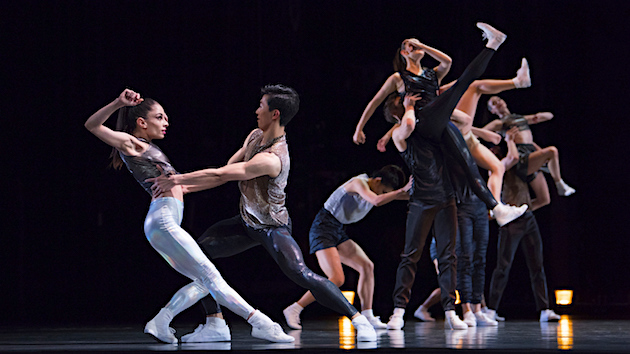
It often feels as vivacious and challenging as some of the best Broadway chorus numbers, and the cast of 14 — six principals, eight corps — is in sneakers, but it seems as fragmented as any dream. Between danced phrases (and they’re often as brief as that) the dancers walk. And walk. But there is no theme to the walking either, it’s an unfocused, perhaps dreamlike ramble. Moments of the walking are a little reminiscent of Jerome Robbins’s Glass Pieces. But the very motif of Glass Pieces was its purposeful, gridded walking. Here, the hurrying goes nowhere, and neither does the dreaming. Some wonderful duets, though, for Dores André and Wei Wang, Sarah van Patten and Luke Ingham, Gabriela Gonzalez and Ulrik Birkkjaer. The electronic music is by M83, a French group with an album that shares the title of the piece.
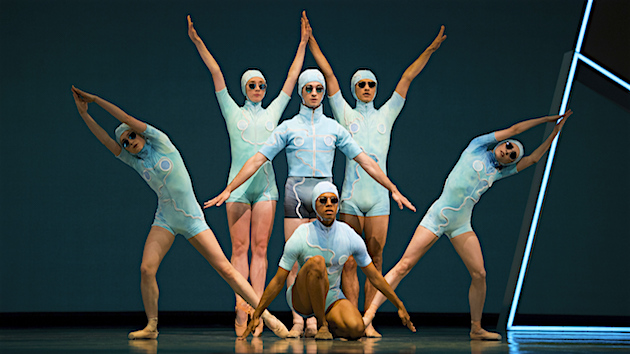
Moving right along, Saturday night’s Program B featured less well-known, but equally busy choreographers, beginning with Otherness. Set to John Adams’s Absolute Jest, it’s SFB corps dancer Myles Thatcher’s fourth work for the company. Offering a funny take on labeling, it explores and sometimes explodes questions of gender. It opens with a head in sunglasses and swimcap peeking through the curtain, soon joined by others in that concealing-revealing combination, set off by two teams in pinkish and bluish gear, one denoting a synchronized swim team, the other more of a clownish sports team.
While advocating for more open acceptance of ungendered behavior, Thatcher acknowledges that even in his ballet, there are differences, and as a dancer making work for dancers, he does honor the verities. Women are on pointe, for instance, and men are not. The choreography has its moments of clever fun, but doesn’t, for the most part, advance the idea of gender stereotyping and the narrowness that drives it.
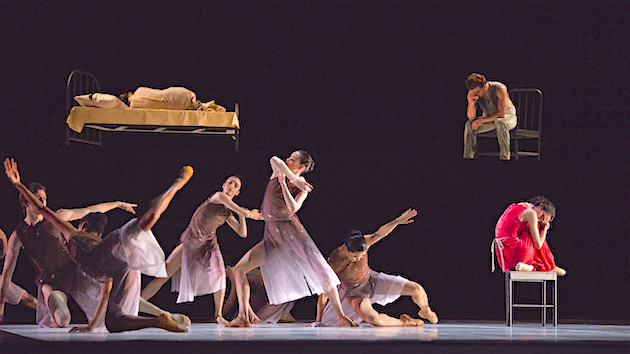
Snowblind, British choreographer Cathy Marston’s take on Edith Wharton’s Ethan Frome (adapted with Patrick Kinmonth, who also did the scenic and costume design), conveys the doleful love triangle — impoverished Ethan (Ulrik Birkkjaer); his older wife, the hypochondriac Zeena (Sarah Van Patten), and her young and ardent aide Mattie (Mathilde Froustey). Marston grabs onto the tale and conveys its ambient despair and chill, as well as its crabbed, impassioned, and illicit love story, with nary an onstage flake.
It took four composers to make up the music, arranged by composer Philip Feeney — the others are Amy Beach, Arthur Foote, and Arvo Pärt. West conducted, and the pianist was Mungunchimeg Buriad. Neighbors and farmhands round out the cast, but the focus is on the principals and they do a wonderful job. Van Patten is, as it turns out, a terrific pill, her narrowly upright carriage, pale blondness, and severity suggesting a cross between avenging harpie and fearful loner. Froustey’s sparkling, gemlike ardor and pliancy is fused with just enough restraint to further drive Birkkjaer into the depths of despair, pain, and lust. Marston, who’s choreographed more than 60 ballets, makes her SFB debut count, with a deft hand for movement and theatrics. It’s easy to see Snowblind as a contender for more performances.
Another Briton, David Dawson, an associate artist of the Dutch National Ballet, was also the first British choreographer to make something for the Mariinsky Ballet. As it turns out, he’s full of surprises, with a list of commissions that would fill an atlas. Anima Animus, set to music by Ezio Bossa, is his SFB debut, and perfectly adequate to mark David Dawson a hidden (to us) treasure.
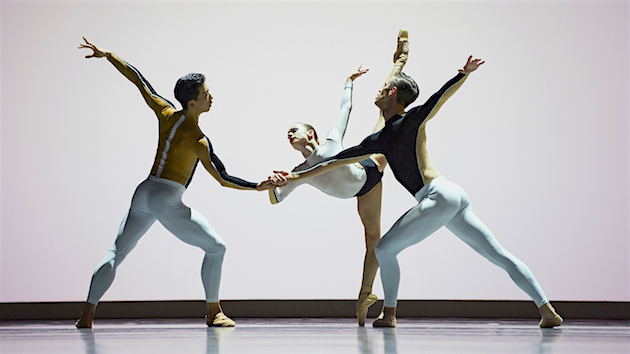
After two nights spent watching ballets that deal with, or aim to deal with, themes and stories and messages, the final piece of Program B, which might be mundanely called a postmodern leotard ballet, has absolutely no aim other than to deliver gorgeous dancing, and does Dawson ever. The writeup in the program book doesn’t say that, but it happens to be true.
Well, maybe it does say that. Dawson encourages his dancers: “Don’t do what you know. Do something beyond. Unbound.” The title Anima Animus is a Jungian-archetype pairing: essentially Dawson is evoking two polarities, male and female, to his dancers, two different kinds of energy. His aim is “to show it all.” And show it all they do. There were moves on the stage that engendered the exciting feeling of a roller coaster when it drops, and others that soared like flights of angels. This is only something of an exaggeration. In summation, this is the first of the Unbound ballets that literally fulfilled the series’ title, and after mentioning the stunning work of the artists who made it happen, notably Maria Kochetkova, Sofiane Sylve, Carlo Di Lanno, Luke Ingham, Henry Sidford, and Wei Wang, your scribe is going to bound out of here.
Correction: This article as orginally published identified Justin Peck as the choreographer for the Broadway revival of South Pacific. The current revival he choreographed is Carousel.
Correction: This article as originally published identified Carlo Bossa as the composer of the music of David Dawson's Anima Animus. His name is Ezio Bossa.

